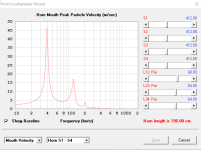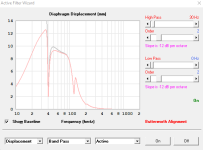Hello,
Hope you had a good weekend!.
Looking for guidance and help regarding a t-line design for car audio purposes only.
Driver
Soundqubed HDS 2.208
https://soundqubed.com/8--hds-2.2-series-subwoofer/
called them to confirm RE

I am planning to have two of these. They are Dual Voice Coil 4ohm and will be wired in parallel for a total of 1ohm. Hence I have selected ND as 2P and the same for BL (blp) signifying voice coils wired in parallel. Eg was input as 1000W and 1ohm hence 31.62. Followed the old school guide of line length (196cm) calculated from Fs and line area from cone area (412 in this case as I have 2 subs).

Frequency Response

Next I checked the displacement. It was exceeding max of 13mm but a subsonic or high pass filter at 30hz should take care of that.


I also checked group delay and mouth velocity. From what I have read about ported box, group delay of around 40 is fine. As for mouth velocity, they say that needs to be around 30 but this 45 is at 1000w input. Not sure if at that power I will actually hear the port noise.


Questions I have
Questions You might have for me
Please let me know in case you have any more questions for me.
Thanks a lot for reading and hope you have a good day ahead.
Edit
Attaching Hornresp export for dualhds208
Hope you had a good weekend!.
Looking for guidance and help regarding a t-line design for car audio purposes only.
Driver
Soundqubed HDS 2.208
https://soundqubed.com/8--hds-2.2-series-subwoofer/
called them to confirm RE
I am planning to have two of these. They are Dual Voice Coil 4ohm and will be wired in parallel for a total of 1ohm. Hence I have selected ND as 2P and the same for BL (blp) signifying voice coils wired in parallel. Eg was input as 1000W and 1ohm hence 31.62. Followed the old school guide of line length (196cm) calculated from Fs and line area from cone area (412 in this case as I have 2 subs).
Frequency Response
Next I checked the displacement. It was exceeding max of 13mm but a subsonic or high pass filter at 30hz should take care of that.
I also checked group delay and mouth velocity. From what I have read about ported box, group delay of around 40 is fine. As for mouth velocity, they say that needs to be around 30 but this 45 is at 1000w input. Not sure if at that power I will actually hear the port noise.
Questions I have
- Assuming this is based on old school quarter wave theory, Have I done or made any wrong assumptions till now.
- Since my goal is to put the t-line in the trunk of a car, do I really need to care about the sharp drop at 120hz? Most car audio setups will set a low pass filter at 100-120hz if not lower at around 80hz. I have read and simulated that to fix this we can place the subs roughly at around 1/3 down the line. If placing 1/3 down the line is not possible, then even having subs and vent diagonally opposite or as far away from each as possible will help because the "Path" comes into picture. Hopefully my understanding of "Path" is correct.
- I know this is the old school design and can be improved, but how do I go about it. In my forum introduction thread Dave aka @planet10 mentioned "Sd has little to nothing to do the line design. Vas is what is pertinent". Can someone please explain this to me.
- The peak at around 40hz I believe can be fixed by some stuffing either in first 1/3 of line or last 1/3.
- Do I need to worry about Group Delay and Mouth Velocity. If so, how do I reduce those.
- All sims assume that the box is a straight line, which it might not be and in this case it won't be. What affect does line folding have.
- If these drivers are not suited for a t-line, then please suggest some others or what to look for when choosing drivers for a t-line.
Questions You might have for me
- What are the goals? An SQL system
- Why duals 8's? 8-9 years back I had a t-line in my car but it was not designed or built by me, I knew nothing about t-lines. I lost the car and system in a crash. I want to put subs in my car again and there was nothing I didn't like about it. It could get loud if I wanted it to, and if I turned down the bass knob it would not bother the neighbors 😉. I am trying to recreate the same setup. The exterior dimensions of the box were around 30" wide x 22" deep and 11.5" high, .075" birch plywood. I am limited by height if 11.5 for putting the box in the trunk. Once in the trunk I should be able to add a baffle (to raise the total height some more) in case I decide to replace the dual 8's with a single 12. I believe max side I can go is 34" and depth be 24". If depth is 24 then subs will have to be mounted along the depth face (which could be good as they would be closer to 1/3 down the line).
Please let me know in case you have any more questions for me.
Thanks a lot for reading and hope you have a good day ahead.
Edit
Attaching Hornresp export for dualhds208
Attachments
Last edited:
Thanks ...Tune it lower and taper it
can you please let me know the starting and ending area for the taper and how many steps...
Yeah, using Qes rather than Qts due to high thermal power distortion I get a ~31.47 L, 31.46 Hz max flat alignment, so to the first approximation what do we get with his straight pipe reduced to 160.54 cm^2 CSA?Tune it lower and taper it
Greets!Hello
Welcome!
FYI: please always Export/attach your HR designs for us to DL, better help. TIA 😉
Hello ,Yeah, using Qes rather than Qts due to high thermal power distortion I get a ~31.47 L, 31.46 Hz max flat alignment, so to the first approximation what do we get with his straight pipe reduced to 160.54 cm^2 CSA?
when you get a chance can you please ELI5 what this means, or point me to where I can read about it.
Also attached HR export to OP. Apologies I didn't think of it earlier.
In general, the higher the power, the hotter the VC the less it handle and the larger the box's net volume (Vb) and the lower the tuning it ideally needs to be for a max flat alignment*, so while one ideally needs to thermal power test a driver, some of us make do with using Qes, some add some resistance (Rg) and most DIYers simply ignore it.
Vb = pathlength (L) x cross sectional area (CSA) (S1, etc., so HR's comprehensive Help File for all things HR 😉).
*
T/S max flat alignment:
Vented net volume (Vb) (L) = 20*Vas*Qts'^3.3
(Ft^3 = (Vb)/~28.31685)
Vented box tuning (Fb) (Hz) = 0.42*Fs*Qts'^-0.96
F3 (Hz) = Fs*0.28*Qts'^-1.4
(Qts'): (Qts) + any added series resistance (Rs)
+++++++++++++++
The box only loads the driver to its upper mass corner (Fhm), i.e. 40 Hz Fs, 120 Hz Fhm:
Qts': 2*Fs/Fhm = 2*40/120 = 0.67, so good for going less expensive, but if wanting a low(er) Qts', then either raise Fhm or lower Fs.
Fhm = 2*Fs/Qts'
Fs: Fhm*Qts'/2
+++++++++++++++
T/S Explained
T/S Equations and how each one affects the others
Vb = pathlength (L) x cross sectional area (CSA) (S1, etc., so HR's comprehensive Help File for all things HR 😉).
*
T/S max flat alignment:
Vented net volume (Vb) (L) = 20*Vas*Qts'^3.3
(Ft^3 = (Vb)/~28.31685)
Vented box tuning (Fb) (Hz) = 0.42*Fs*Qts'^-0.96
F3 (Hz) = Fs*0.28*Qts'^-1.4
(Qts'): (Qts) + any added series resistance (Rs)
+++++++++++++++
The box only loads the driver to its upper mass corner (Fhm), i.e. 40 Hz Fs, 120 Hz Fhm:
Qts': 2*Fs/Fhm = 2*40/120 = 0.67, so good for going less expensive, but if wanting a low(er) Qts', then either raise Fhm or lower Fs.
Fhm = 2*Fs/Qts'
Fs: Fhm*Qts'/2
+++++++++++++++
T/S Explained
T/S Equations and how each one affects the others
T/S max flat alignment:
so per my calculation., for this driver.
qts 0.51
vas 5.319
fs 44.41
vb (l) 20*Vas*Qts'^3.3 = 11.53032549
f3 Fs*0.28*Qts'^-1.4 = 31.91835921
fb 0.42*Fs*Qts'^-0.96 = 35.60104078
those numbers are for one sub. are those numbers correct? will vb double if we have two drivers?
if we use new qts calculator, then
qts 0.608
vas 5.319
fs 44.41
vb (l) 20*Vas*Qts'^3.3 = 20.59405165
f3 Fs*0.28*Qts'^-1.4 = 24.955932
fb 0.42*Fs*Qts'^-0.96 = 30.07340669
- Home
- Loudspeakers
- Subwoofers
- T-Line Design Help/Review

